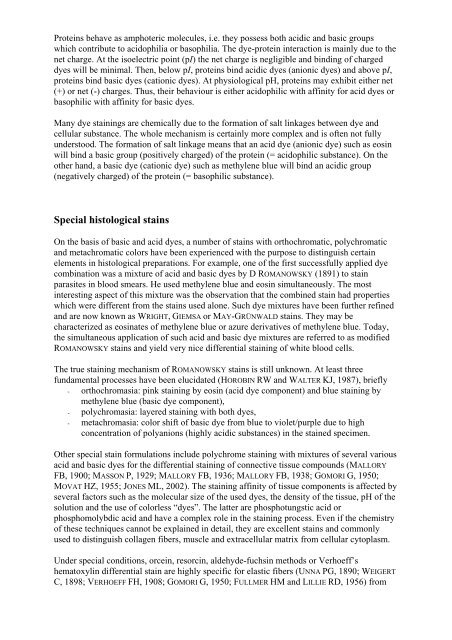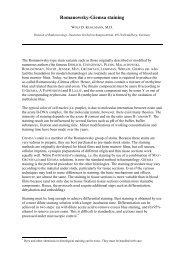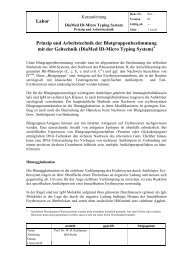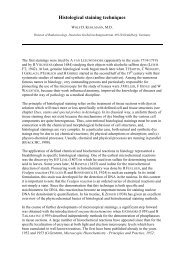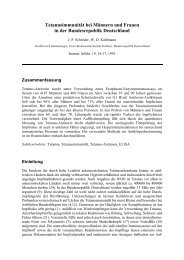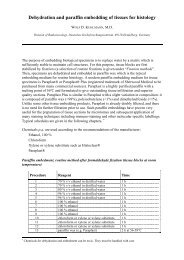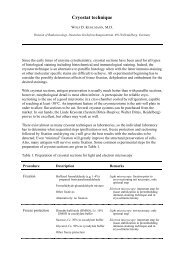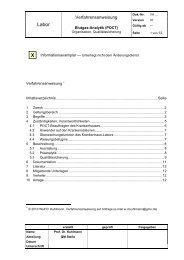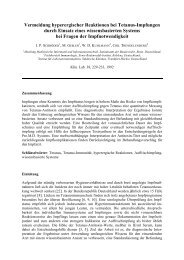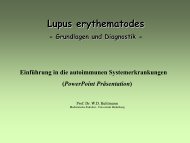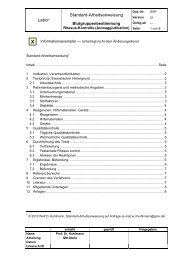Dyes, stains, and special probes in histology
Dyes, stains, and special probes in histology
Dyes, stains, and special probes in histology
Create successful ePaper yourself
Turn your PDF publications into a flip-book with our unique Google optimized e-Paper software.
Prote<strong>in</strong>s behave as amphoteric molecules, i.e. they possess both acidic <strong>and</strong> basic groupswhich contribute to acidophilia or basophilia. The dye-prote<strong>in</strong> <strong>in</strong>teraction is ma<strong>in</strong>ly due to thenet charge. At the isoelectric po<strong>in</strong>t (pI) the net charge is negligible <strong>and</strong> b<strong>in</strong>d<strong>in</strong>g of chargeddyes will be m<strong>in</strong>imal. Then, below pI, prote<strong>in</strong>s b<strong>in</strong>d acidic dyes (anionic dyes) <strong>and</strong> above pI,prote<strong>in</strong>s b<strong>in</strong>d basic dyes (cationic dyes). At physiological pH, prote<strong>in</strong>s may exhibit either net(+) or net (-) charges. Thus, their behaviour is either acidophilic with aff<strong>in</strong>ity for acid dyes orbasophilic with aff<strong>in</strong>ity for basic dyes.Many dye sta<strong>in</strong><strong>in</strong>gs are chemically due to the formation of salt l<strong>in</strong>kages between dye <strong>and</strong>cellular substance. The whole mechanism is certa<strong>in</strong>ly more complex <strong>and</strong> is often not fullyunderstood. The formation of salt l<strong>in</strong>kage means that an acid dye (anionic dye) such as eos<strong>in</strong>will b<strong>in</strong>d a basic group (positively charged) of the prote<strong>in</strong> (= acidophilic substance). On theother h<strong>and</strong>, a basic dye (cationic dye) such as methylene blue will b<strong>in</strong>d an acidic group(negatively charged) of the prote<strong>in</strong> (= basophilic substance).Special histological <strong>sta<strong>in</strong>s</strong>On the basis of basic <strong>and</strong> acid dyes, a number of <strong>sta<strong>in</strong>s</strong> with orthochromatic, polychromatic<strong>and</strong> metachromatic colors have been experienced with the purpose to dist<strong>in</strong>guish certa<strong>in</strong>elements <strong>in</strong> histological preparations. For example, one of the first successfully applied dyecomb<strong>in</strong>ation was a mixture of acid <strong>and</strong> basic dyes by D ROMANOWSKY (1891) to sta<strong>in</strong>parasites <strong>in</strong> blood smears. He used methylene blue <strong>and</strong> eos<strong>in</strong> simultaneously. The most<strong>in</strong>terest<strong>in</strong>g aspect of this mixture was the observation that the comb<strong>in</strong>ed sta<strong>in</strong> had propertieswhich were different from the <strong>sta<strong>in</strong>s</strong> used alone. Such dye mixtures have been further ref<strong>in</strong>ed<strong>and</strong> are now known as WRIGHT, GIEMSA or MAY-GRÜNWALD <strong>sta<strong>in</strong>s</strong>. They may becharacterized as eos<strong>in</strong>ates of methylene blue or azure derivatives of methylene blue. Today,the simultaneous application of such acid <strong>and</strong> basic dye mixtures are referred to as modifiedROMANOWSKY <strong>sta<strong>in</strong>s</strong> <strong>and</strong> yield very nice differential sta<strong>in</strong><strong>in</strong>g of white blood cells.The true sta<strong>in</strong><strong>in</strong>g mechanism of ROMANOWSKY <strong>sta<strong>in</strong>s</strong> is still unknown. At least threefundamental processes have been elucidated (HOROBIN RW <strong>and</strong> WALTER KJ, 1987), briefly- orthochromasia: p<strong>in</strong>k sta<strong>in</strong><strong>in</strong>g by eos<strong>in</strong> (acid dye component) <strong>and</strong> blue sta<strong>in</strong><strong>in</strong>g bymethylene blue (basic dye component),- polychromasia: layered sta<strong>in</strong><strong>in</strong>g with both dyes,- metachromasia: color shift of basic dye from blue to violet/purple due to highconcentration of polyanions (highly acidic substances) <strong>in</strong> the sta<strong>in</strong>ed specimen.Other <strong>special</strong> sta<strong>in</strong> formulations <strong>in</strong>clude polychrome sta<strong>in</strong><strong>in</strong>g with mixtures of several variousacid <strong>and</strong> basic dyes for the differential sta<strong>in</strong><strong>in</strong>g of connective tissue compounds (MALLORYFB, 1900; MASSON P, 1929; MALLORY FB, 1936; MALLORY FB, 1938; GOMORI G, 1950;MOVAT HZ, 1955; JONES ML, 2002). The sta<strong>in</strong><strong>in</strong>g aff<strong>in</strong>ity of tissue components is affected byseveral factors such as the molecular size of the used dyes, the density of the tissue, pH of thesolution <strong>and</strong> the use of colorless “dyes”. The latter are phosphotungstic acid orphosphomolybdic acid <strong>and</strong> have a complex role <strong>in</strong> the sta<strong>in</strong><strong>in</strong>g process. Even if the chemistryof these techniques cannot be expla<strong>in</strong>ed <strong>in</strong> detail, they are excellent <strong>sta<strong>in</strong>s</strong> <strong>and</strong> commonlyused to dist<strong>in</strong>guish collagen fibers, muscle <strong>and</strong> extracellular matrix from cellular cytoplasm.Under <strong>special</strong> conditions, orce<strong>in</strong>, resorc<strong>in</strong>, aldehyde-fuchs<strong>in</strong> methods or Verhoeff’shematoxyl<strong>in</strong> differential sta<strong>in</strong> are highly specific for elastic fibers (UNNA PG, 1890; WEIGERTC, 1898; VERHOEFF FH, 1908; GOMORI G, 1950; FULLMER HM <strong>and</strong> LILLIE RD, 1956) from


